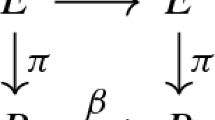Conclusion and Summary
We have given what, we hope, are precise statements of the main principles that underly general relativity. It is not our intention to argue that these statements correspond to the original statements of these principles. We have used the original terms, principle of equivalence, etc., to designate the formulations given here primarily for convenience and because we feel that our formulations are, at least, in the spirit of the general accepted meaning of these appellations. Our formulation of these principles rests primarily on the observation that there are two types of objects that appear in the descriptions of physical systems, which we have termed absolute and dynamical. A covariance group consists of those transformations which transform one observable set of values of these objects into another observable set and correspond to the passive transformations that one can carry out on the system. An invariance group is the subgroup of a covariance group that leaves invariant the absolute objects. If there are no absolute objects, the two groups coincide.
The principle of general covariance asserts that the Einstein group, that is, ‘the group of arbitrary local coordinate transformations’, is a covariance group of all physical systems that can be described by space-time theories. The requirement that the Einstein group is also an invariance group of all physical systems constitutes the principle of general invariance. Support for this latter principle comes first from a Machian type of argument that there should be no absolute objects in nature. A weak form of the principle of equivalence that asserts the equivalence of inertial effects to gravitational effects (but not necessarily conversely) allows one to conclude the impossibility of distinguishing between arbitrary active and passive coordinate transformations. Since the latter transformations constitute the Einstein group, we conclude that the former also constitute this group. Since the active transformations constitute an invariance group, we are again led to the conclusion that the Einstein group is the invariance group, of all spacetime systems.
Similar content being viewed by others
ReferencesReferences
Einstein, A. (1918).Ann. Physik (Leipzig),55, 241.
See, for example, the discussion in Anderson, J. L. and Gautreau, R. (1969)Phys. Rev.,185, No. 5, 1656.
Kretschmann, E. (1917)Ann. Physik (Leipzig),53, 575.
Fock, V. (1964).The Theory of Space, Time, and Gravitation, Pergamon Press, Oxford.
Einstein, A. (1955)The Meaning of Relativity. Princeton University Press, Princeton, p. 100.
See. for example,Gravitation, and Relativity, Chiu and Hoffmann (1964). Eds. W. A. Benjamin, Inc., New York, Chaps. 7 and 15.
Anderson, J. L. (1967).Principles of Relativity Physics, Academic Press, New York, Chap. 4.
Eckart, C. (1940).Phys. Rev.,58, 919.
Landau, L. D. and Lifshitz, E. M. (1962).Fluid Mechanics, Addison-Wesley, Reading, Mass. Chap. XV.
Nöther, E. (1918),Nachr. Ges. Wiss. Göttingen, 211.
It is just this fact that makes it impossible in general to define a unique stress-energy for the gravitational field.
For a covariant formulation of Newtonian mechanics, see Trautman, A. (1963),Compte-rendu hebdomadaire des Séances de l'Académie des sciences,257, 617; Friedrichs, K. (1927).Math. Ann. 98, 566.
Eötvös, R. (1891).Math. natur. Berichte Ungarn. 8, 65.
Dicke, R. H. (1961).Sci. Am. 205, No. 6, 84.
Dicke, R. H. ref. 6, Chap. 1.
Author information
Authors and Affiliations
Rights and permissions
About this article
Cite this article
Anderson, J.L. Covariance, invariance, and equivalence: A viewpoint. Gen Relat Gravit 2, 161–172 (1971). https://doi.org/10.1007/BF02450447
Received:
Issue Date:
DOI: https://doi.org/10.1007/BF02450447




